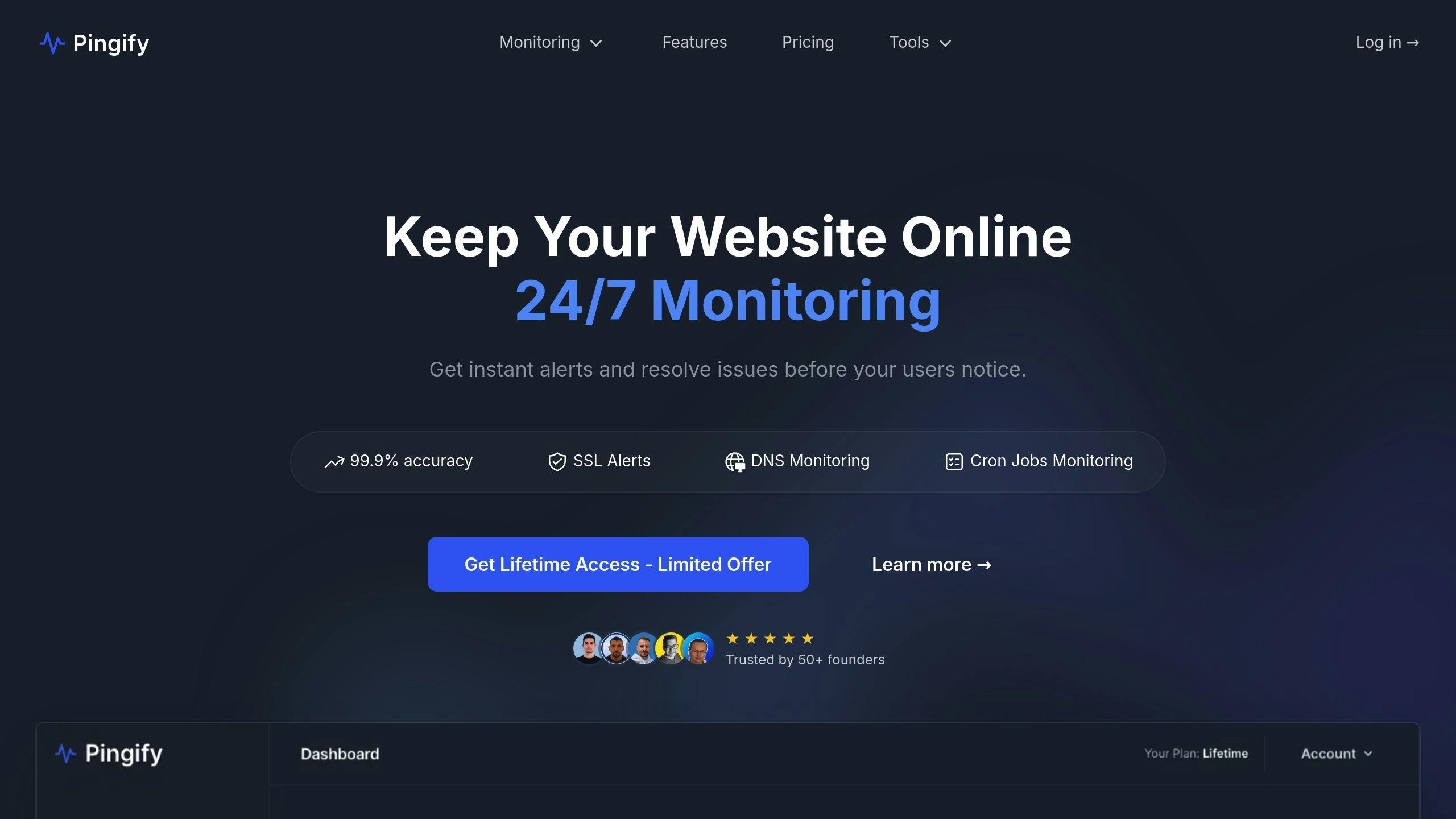Website Uptime vs Downtime: Impact on Business Revenue

Website Uptime vs Downtime: Impact on Business Revenue
Did you know website downtime can cost businesses $5,600 per minute? For larger companies, this number skyrockets to $301,000–$400,000 per hour. Beyond financial losses, downtime damages brand reputation for 60% of businesses and reduces customer satisfaction for 45%.
To avoid these risks, businesses rely on uptime monitoring tools like Pingify, UptimeRobot, and StatusCake. These tools provide real-time alerts, monitor critical areas like SSL and DNS, and help businesses resolve issues quickly to protect revenue and customer trust.
Quick Overview:
- Pingify: Budget-friendly lifetime plans starting at $39, with real-time monitoring and alerts.
- UptimeRobot: Free basic plan; Pro plan at $15/month for advanced features.
- StatusCake: Enterprise-level solutions with server tracking and API integration.
Website uptime isn’t just about keeping a site online - it’s about safeguarding revenue, customer loyalty, and business stability. Let’s explore how these tools can help.
1. Pingify

Uptime Monitoring Features
Pingify keeps a close eye on your website's performance by monitoring key areas like HTTP, SSL, DNS, and even keywords. With checks happening every minute, it delivers detailed insights to help businesses spot and fix issues before they can cause any damage.
Real-Time Notifications
When something goes wrong, Pingify ensures you're the first to know. It sends instant alerts through email, Slack, Telegram, webhooks, and Pushover, so you can act fast and minimize any downtime.
Pricing and Scalability
Pingify has two lifetime plan options:
- Essentials ($39): Covers up to 10 monitors.
- Pro ($69): Offers unlimited monitors.
Both plans include 1-minute checks and unlimited notifications, giving businesses flexibility based on their needs.
Protecting Revenue and Customer Trust
By providing real-time alerts and monitoring critical areas like SSL, DNS, and HTTP, Pingify helps businesses tackle downtime quickly. This reduces the risk of losing customer trust or revenue due to poor website performance. From customer-facing pages to backend systems, Pingify ensures everything stays up and running.
While Pingify is a solid choice for monitoring and protecting your business, it's worth considering other tools that might offer features tailored to your specific needs.
2. Other Uptime Monitoring Tools
Advanced Monitoring Solutions
Tools like UptimeRobot and StatusCake bring distinct strengths to the table. UptimeRobot is known for its keyword monitoring, while StatusCake caters to larger operations with server tracking and API integrations. Both tools help businesses spot problems as they happen, ensuring quick fixes to maintain operations and avoid revenue loss [5].
Alert Systems and Response
Today's monitoring platforms connect with various communication tools, sending instant alerts to teams through their preferred channels. This setup ensures technical issues are addressed quickly, reducing the risk of interruptions that could harm revenue [2][3].
Pricing Options
UptimeRobot provides a free plan for basic needs, while its Pro plan includes more advanced features at $15/month. StatusCake, on the other hand, offers flexible enterprise-level plans that businesses can tailor to their specific needs, making it easier to scale monitoring efforts as they grow.
Revenue Protection Impact
Website performance plays a major role in business outcomes. Oracle's research emphasizes this point:
"89% of customers began doing business with a competitor following a poor customer experience" [5].
This underscores how uptime monitoring helps safeguard customer satisfaction and revenue. By using tools like UptimeRobot or StatusCake, businesses can catch and fix problems before they disrupt customer experiences or sales [2][3].
How to Monitor Your Website's Uptime and Performance
Pros and Cons
When choosing uptime monitoring tools, it’s important to weigh their advantages and drawbacks to ensure your business stays online and safeguards revenue. Below is a comparison of some popular options:
| Tool | Pros | Cons |
|---|---|---|
| Pingify | • Real-time checks every minute • Monitors SSL, DNS, and cron tasks • Lifetime pricing with multiple alerts |
• Limited monitors on the basic plan • No API access • Relatively new platform |
| UptimeRobot | • Strong keyword monitoring • Free tier available • Integrates with various tools |
• Monthly fees for advanced features • Basic features in free plan are limited • Pro plan needed for premium tools |
| StatusCake | • Advanced monitoring for enterprises • Detailed server tracking • Full API support |
• Higher cost • Steeper learning curve • Setup can be complex |
The choice of tool directly impacts how well businesses can prevent downtime, protect revenue, and maintain customer trust. For instance, Pingify is a budget-friendly option for small and medium businesses, offering lifetime access starting at $39. On the other hand, StatusCake caters to enterprises with its advanced features but comes at a higher price.
"89% of customers began doing business with a competitor following a poor customer experience" [5]
This insight from Oracle highlights the importance of reliable monitoring tools to ensure uptime and avoid losing customers. When selecting a solution, focus on how well it meets your business needs, considering factors like notification speed, integration options, and scalability.
Ultimately, the right tool is one that aligns with your goals and ensures your systems stay up and running.
Conclusion
Website uptime has a direct influence on business revenue. In the UK alone, even a 0.1% downtime could result in losses of up to £440 billion over five years [4]. This underscores the need for effective monitoring solutions.
Frequent downtime creates several problems for businesses: lost sales, increased operational expenses, and damage to both brand reputation and customer trust. These challenges make it crucial for businesses to take action to safeguard their online presence.
Here are two key strategies businesses should focus on:
-
Proactive Monitoring and Response: Tools like Pingify and UptimeRobot provide real-time alerts and features such as SSL, DNS, and cron task monitoring, helping teams quickly resolve issues before they escalate.
-
Regular Infrastructure Audits: Conducting routine checks on infrastructure to identify and address vulnerabilities that may lead to downtime.
For smaller businesses, Pingify offers an affordable entry point with lifetime access starting at $39, making professional monitoring accessible. Larger organizations may require advanced solutions with features like detailed analytics and API integration to meet their needs.
In today’s digital world, website reliability is more than just a technical issue - it’s critical for staying competitive. Customers expect constant availability, so investing in uptime monitoring is a smart move to protect revenue and ensure long-term business stability.
FAQs
How much does downtime cost for a website?
Downtime can have a serious financial impact, varying based on the size and industry of a business. For small and medium-sized businesses, poor website performance results in an average loss of $20,172 annually [1].
For larger companies, the stakes are even higher. Take Facebook's six-hour outage in October 2021 - it cost the company $164,000 per minute, adding up to a staggering $60 million in lost revenue [5]. On average, downtime costs range from $137 per minute for small businesses to $9,000 per minute for large enterprises.
But the financial toll doesn’t stop there. Poor website performance also affects customer loyalty and revenue. According to research:
"89% of customers began doing business with a competitor following a poor customer experience" [5].
Even a delay as short as one second can hurt conversions, reducing them by 7% [5]. These numbers underscore how crucial it is to have tools and plans in place to maintain website uptime.
Services like Pingify and UptimeRobot can help reduce these risks. They offer real-time monitoring and fast incident response, helping businesses maintain website reliability and safeguard their revenue. By using these tools, companies can catch and fix issues before they escalate.
